
Transcription
ELLA BAKER CENTER for HUMAN RIGHTS
She led. So can you.
April 2, 2021
Dear Friend,
As we navigate the uncertainty and adversity of the COVID-19 pandemic, we have been fighting for mass releases and policy change to ensure the safety of our community -- particularly our incarcerated community. During the last year our mailing list tripled in size! This means that our community is stronger than ever, and it also means that it may take us longer to respond to your letters. We apologize if you wrote and we didn't reply to you yet. We are doing our best and will try to be in touch as soon as possible!
New Credits Rolling Out Summer 2021
On March 12, 2021, CDCR Secretary Allison was interviewed by the Anti-Recidivism Coalition's Executive Director Sam Lewis and she announced new credit-earning policies that will be introduced by Summer 2021, with regulations to be released by then that will go into more detail. Here are the credits she discussed with the caveat, "I'm getting ahead of myself because we have not released these regulations." Kathleen also remarked that unlike the 12-week programming credit awarded in 2020, "there's no exclusionary criteria."
● All people with "nonviolent" cases who have Proposition 57 eligible 2nd strike and 3rd strike sentences will get 50% off their sentence.
● People with "violent" cases will go from 20% to 33 1/3% off their sentence except those with Death Penalty or LWOP cases.
● People will be able to take tests to get programming credits if they have been doing correspondence coursework during the pandemic.
● Everyone who is impacted by these new credits will get a new letter with their new date.
● Secretary Allison also stressed that the new credit earning rates will not be retroactive.
● There are currently no plans to offer another 12 weeks of positive programming credits.
COVID-19 Stimulus Payments
We have been receiving a lot of questions about the new stimulus that the U.S. Congress recently paid. Payments will be automatically made via the method used for the first stimulus payment. If you are preparing o file your 2020 tax return you cannot use the old EIP 2019 form. The IRS is now requiring people to file a full 1040 form to receive these stimulus payments, even if they would not normally file taxes because they do not have income over $12,200 (or $2,4400 if filing a joint return). We can send you sample and blank 1040 forms you can use if they have not already been passed out in your facility. While no debts or restitution (other than child support) could be taken from the first two stimulus payments, if you are still owed these two stimulus payments and are filing for them as a 2020 tax refund, then there are not currently protections against debt and restitution being taken from your stimulus payments.
ELLA BAKER CENTER for HUMAN RIGHTS
She led. So can you.
Updates from the CDCR, Courts and Parole Board: On October 20th, there was a victory that incarcerated organizers at San Quentin (SQSP) and outside advocates had been fighting for throughout the COVID-19 pandemic: the First District Court of Appeal ruled that SQSP acted with deliberate indifference and that relief is warranted in order to prevent further illness and suffering as a result of the pandemic. The ruling directed SQSP to reduce the population to 1,775 people by either release or transfer.
On December 23rd, The California Supreme Court issued a decision on the Court of Appeal's Von Staich decision, and ruled to send the case back down to the Court of Appeals. This means the previous order to reduce the SQSP population is now "vacated" (no longer exists). This decision is extremely disappointing. The CA Supreme Court has ordered the Court of Appeal to reconsider holding an evidentiary hearing. On February 24th, the Court of Appeals issued their second order in the Von Steich case - this time they have decided to send that case back to the Marin County Superior Court to hold an evidentiary hearing on the matter. There's a case management conference on Friday 3/19 consolidating the cases, scheduling an evidentiary hearing, and deciding "Whether the court should consider any question at the hearing other than when the present conditions under which the state has confined petitioners violate...". At this time, it is not clear exactly how this will impact the habeas petitions currently pending in Marin County Superior Court, but we will update with information on that as soon as possible. Attorneys are encouraging people at all prisons to file habeas petitions to show that the issue is not isolated to SQSP, but that conditions are cruel and unusual at every prison.
In February 2021, the Office of the Inspector General (OIG) released their third report in a COVID-19 Review Series. The report outlines how the California Correctional Health Care Services (CCHCS) and CDCR caused a public health disaster at SQSP when they transferred medically vulnerable incarcerated persons from the California Institution for Men (CIM) without taking proper safeguards. One of the most haunting findings established by this report is that CDCR and CCHCS deliberately pushed forward the transfer, full aware of the deadly risks at hand and despite multiple objections and warnings from their own medical staff about the grave risk this created. The report notes that a CCHCS executive stated: "The benefit of a more rapid move in this specific situation appears to outweigh the risks." Advocates from the #StopSanQuentinOutbreak coalition continues to call for large-scale releases without categorical exclusions to urgently decarcerate prisons to below 50% of current capacity as the only health solution to COVID-19 outbreaks across California.
Expedited Release: In March 2020, CDCR released 3,500 people early to reduce crowding and in July a started COVID-19 Expedited Release program, which reviewed people for early release who have 1 year or less to serve on their sentence. Between July 1, 2020 and January 20, 2021, 7,2529 people were released early through the COVID-19 early-release programs. As of January 2021, the COVID-19 Expedited Release program has been suspended. The only expedited release program still in effect is the 180-day early-release. Between December 3, 2020 and January 13, 2021 - the 180 day release program resulted in 362 early releases. That is a small number relative to the more than 1,700 "natural releases" that, according to CDCR data, happened during that same time period. CDCR has started instead to refer people back to court for PC § 1170(d)(1) resentencing based on their vulnerability to COVID, if they have a medical risk score of 3 or higher, a determinate sentence, and if they have a non-sexual case history. As of January 25, 2021, 15 were released and an additional 153 were referred to the courts for consideration under Penal Code section 1170(d)(1). The only current early-release programs still available is for some within 180-days of release (see more information below). According to the Prison Law Office, of the approximately 6,200 people who were eligible for consideration of release under the "high-risk medical release" program Governor Newsom announced on July 10, roughly 3,900 are serving indeterminate terms. Currently only determinately sentenced people are being considered under this program. Of the ~2,900 people in that cohort, ~1,100 have been considered and 41 approved for release and as of August 26th, only 16 have actually been released. As of March 12, 2021, the Governor granted medical reprieves of sentences to 10 additional individuals deemed high risk for COVID-19. These individuals range in age from 56 to 77 years old.
VACCINATIONS: COVID-19 vaccines that have been authorized by FDA have been carefully evaluated in clinical trials for their ability to protect us from COVID-19. CDC advises people to get the vaccine even if they have been sick with COVID-19 before. As of April 2nd, 42,788 incarcerated individuals have been fully vaccinated and 17,788 have received their first-dose. 24,592 staff members have been fully vaccinated and 2,391 have received their first dose.[1] It is their intent to offer COVID-19 vaccinations to all CDCR and CCHCS employees and incarcerated individuals. CDCR is prioritizing incarcerated persons who are over the age of 65 and those who have a higher risk of complications from COVID. Vaccine distribution is based on several criteria including patient risk factors and interaction with potentially infected patients. This includes: staff and residents at skilled-nursing facilities, frontline workers and correctional staff at other facilities, and vulnerable incarcerated people such as folks incarcerated in either a Correctional Treatment Center (CTC) or Outpatient Housing Unit (OHU).
COVID DEATHS: We regret to share that there have been 216 people in CDCR who have died from the disease. See the following CDCR chart (From the CDCR website, April 2nd, 2021) for confirmed COVID-19 cases and outcomes of individual institutions.
[1] Staff vaccination rates are under-reported as they can also receive a vaccine from an outside health-care provider.
ELLA BAKER CENTER for HUMAN RIGHTS
She led. So can you.
CDCR PATIENTS: CONFIRMED COVID-19 AND OUTCOMES
Institution: CCWF Institution Name: Central CA Women's Facility Confirmed: 821 New in Last 14 Days: 15 Active in Custody: 15 Released While Active: 1 Resolved: 804 Deaths: 1
Institution: SAC Institution Name: CA State Prison, Sacramento Confirmed: 292 New in Last 14 Days: 5 Active in Custody: 5 Released While Active: 2 Resolved: 284 Deaths: 1
Institution: SVSP Institution Name: Salinas Valley State Prison Confirmed: 684 New in Last 14 Days: 5 Active in Custody: 4 Released While Active: 6 Resolved: 669 Deaths: 5
Institution: CHCF Institution Name: California Health Care Facility Confirmed: 619 New in Last 14 Days: 1 Active in Custody: 2 Released While Active: 3 Resolved: 600 Deaths: 14
Institution: CIW Institution Name: CA Institution for Women Confirmed: 489 New in Last 14 Days: 2 Active in Custody: 2 Released While Active: 10 Resolved: 476 Deaths: 1
Institution: CAL Institution Name: Calipatria State Prison Confirmed: 1,124 New in Last 14 Days: 1 Active in Custody: 1 Released While Active: 10 Resolved: 1,111 Deaths: 2
Institution: CIM Institution Name: CA Institution for Men Confirmed: 1,500 New in Last 1 Days: 1 Active in Custody: 32 Released While Active: 1 Resolved: 1,440 Deaths: 27
Institution: CMC Institution Name: CA Mens Colony Confirmed: 2,470 New in Last 14 Days: 0 Active in Custody: 1 Released While Active: 23 Resolved: 2,436 Deaths: 10
Institution: CVSP Institution Name: Chuckawalla Valley State Prison Confirmed: 1,784 New in Last 14 Days: 1 Active in Custody: 1 Released While Active: 20 Resolved: 1,754 Deaths: 9
Institution: KVSP Institution Name: Kern Valley State Prison Confirmed: 894 New in Last 14 Days: 1 Active in Custody: 1 Released While Active: 6 Resolved: 881 Deaths: 6
Institution: NKSP Institution Name: North Kern State Prison Confirmed: 922 New in Last 14 Days: 1 Active in Custody: 1 Released While Active: 10 Resolved: 907 Deaths: 4
Institution: SOL Institution Name: CA State Prison, Salano Confirmed: 1,150 New in Last 14 Days: 1 Active in Custody: 1 Released While Active: 11 Resolved: 1,133 Deaths: 5
Institution: WSP Institution Name: Wasco State Prison Confirmed: 1,761 New in Last 14 Days: 0 Active in Custody: 1 Released While Active: 44 Resolved: 1,715 Deaths: 1
Institution: CCWF Institution Name: Central CA Women's Facility Confirmed: 821 New in Last 14 Days: 15 Active in Custody: 15 Released While Active: 1 Resolved: 804 Deaths: 1
Institution: ASP Institution Name: Avenal State Prison Confirmed: 3,107 New in Last 14 Days: 0 Active in Custody: 0 Released While Active: 69 Resolved: 3,030 Deaths: 8
Institution: CAC Institution Name: California City Correctional Facility Confirmed: 999 New in Last 14 Days: 0 Active in Custody: 0 Released While Active: 9 Resolved: 968 Deaths: 2
Institution: CCC Institution Name: CA Correctional Center Confirmed: 1,365 New in Last 14 Days: 0 Active in Custody: 0 Released While Active: 33 Resolved: 1,332 Deaths: 0
Institution: CCI Institution Name: CA Correctional Institution Confirmed: 1,382 New in Last 14 Days: 0 Active in Custody: 0 Released While Active: 64 Resolved: 1,314 Deaths: 4
Institution: CEN Institution Name: Centinela State Prison Confirmed: 863 New in Last 14 Days: 0 Active in Custody: 0 Released While Active: 7 Resolved: 855 Deaths: 1
Institution: CMF Institution Name: CA Medical Facility Confirmed: 710 New in Last 14 Days: 0 Active in Custody: 0 Released While Active: 3 Resolved: 696 Deaths: 11
Institution: COR Institution Name: CA State Prison Corcoran Confirmed: 1,075 New in Last 14 Days: 0 Active in Custody: 0 Released While Active: 6 Resolved: 1,066 Deaths: 3
State Total Confirmed: 49,221 New in Last 14 Days: 34 Active in Custody: 36 Released While Active: 611 Resolved: 48,356 Deaths: 218
Data Last Updated: Apr 2 2021 10:37AM
CDCR PATIENTS: CONFIRMED COVID-19 AND OUTCOMES
Institution: CCC Institution Name: CA Correctional Center Confirmed: 1,365 New in Last 14 Days: 0 Active in Custody: 0 Released While Active: 33 Resolved: 1,332 Deaths: 0
Institution: CCI Institution Name: CA Correctional Institution Confirmed: 1,382 New in Last 14 Days: 0 Active in Custody: 0 Released While Active: 64 Resolved: 1,314 Deaths: 4
Institution: CEN Institution Name: Centinela State Prison Confirmed: 863 New in Last 14 Days: 0 Active in Custody: 0 Released While Active: 7 Resolved: 855 Deaths: 1
Institution: CMF Institution Name: CA Medical Facility Confirmed: 710 New in Last 14 Days: 0 Active in Custody: 0 Released While Active: 3 Resolved: 696 Deaths: 11
Institution: COR Institution Name: CA State Prison Corcoran Confirmed: 1,075 New in Last 14 Days: 0 Active in Custody: 0 Released While Active: 6 Resolved: 1,066 Deaths: 3
Institution: CRC Institution Name: CA Rehabilitation Center Confirmed: 1,993 New in Last 14 Days: 0 Active in Custody: 0 Released While Active: 57 Resolved: 1,935 Deaths: 1
Institution: CTF Institution Name: Correctional Training Facility Confirmed: 2,717 New in Last 14 Days: 0 Active in Custody: 0 Released While Active: 29 Resolved: 2,670 Deaths: 18
Institution: DVI Institution Name: Deuel Vocational Institution Confirmed: 543 New in Last 14 Days: 0 Active in Custody: 0 Released While Active: 5 Resolved: 538 Deaths: 0
Institution: FSP Institution Name: Folsom State Prison Confirmed: 1,369 New in Last 14 Days: 0 Active in Custody: 0 Released While Active: 12 Resolved: 1,355 Deaths: 2
Institution: HDSP Institution Name: High Desert State Prison Confirmed: 2,032 New in Last 14 Days: 0 Active in Custody: 0 Released While Active: 6 Resolved: 2,024 Deaths: 2
Institution: ISP Institution Name: Ironwood State Prison Confirmed: 1,568 New in Last 14 Days: 0 Active in Custody: 0 Released While Active: 11 Resolved: 1,556 Deaths: 1
Institution: LAC Institution Name: CA State Prison, LA County Confirmed: 1,511 New in Last 14 Days: 0 Active in Custody: 0 Released While Active: 10 Resolved: 1,488 Deaths: 13
Institution: MCSP Institution Name: Mule Creek State Prison Confirmed: 1,846 New in Last 14 Days: 0 Active in Custody: 0 Released While Active: 2 Resolved: 1,836 Deaths: 8
Institution: PBSP Institution Name: Pelican Bay State Prison Confirmed: 220 New in Last 14 Days: 0 Active in Custody: 0 Released While Active: 5 Resolved: 215 Deaths: 0
Institution: PVSP Institution Name: Pleasant Valley State Prison Confirmed: 1,989 New in Last 14 Days: 0 Active in Custody: 0 Released While Active: 13 Resolved: 1,973 Deaths: 3
Institution: RDJ Institution Name: R.J. Donovan Corr. Fac. Rock Mtn. Confirmed: 1,011 New in Last 14 Days: 0 Active in Custody: 0 Released While Active: 1 Resolved: 992 Deaths: 18
Institution: SATF Institution Name: Substance Abuse Treatment Facility Confirmed: 3,011 New in Last 14 Days: 0 Active in Custody: 0 Released While Active: 15 Resolved: 2,989 Deaths: 7
Institution: SCC Institution Name: Sierra Conservation Center Confirmed: 1,429 New in Last 14 Days: 0 Active in Custody: 0 Released While Active: 18 Resolved: 1,411 Deaths: 0
Institution: SQ Institution Name: CA State Prison, San Quentin Confirmed: 2,241 New in Last 14 Days: 0 Active in Custody: 0 Released While Active: 43 Resolved: 2,170 Deaths: 28
Institution: VSP Institution Name: Valley State Prison Confirmed: 1,730 New in Last 14 Days: 0 Active in Custody: 0 Released While Active: 15 Resolved: 1,713 Deaths: 2
State Total Confirmed: 49,221 New in Last 14 Days: 34 Active in Custody: 36 Released While Active: 611 Resolved: 48,356 Deaths: 218
Data Last Updated: Apr 2 2021 10:37AM
Phased Reopening of In-Person Visiting: After suspending in-person visiting statewide in March 2020 at the onset of the COVID-19 pandemic health emergency, California Department of Corrections and Rehabilitation (CDCR) has worked to begin a phased reopening that will allow limited in-person visitation beginning April 10, 2021. There will be significant changes to visiting operations, including new protocols such as temperature and symptom screenings, COVID-19 testing, physical distancing, face coverings, limiting the number of visitors at a given time, length of time allowed for each visit, and other expectations for visitors. Video visitation, which has been ongoing at all 35 state prisons since late last year, will continue at institutions and fire camps where feasible. Additionally, the Warden and Chief Executive Officer of each institution will determine whether facilities within institutions are safe to conduct in-person visiting. Institutions will update their web page on the CDCR website to keep visitors informed. The date that an institution resumes in-person visiting will depend upon the number of active patient and staff cases at each institution. It is important to note that multiple considerations may affect the speed at which institutions and program areas reopen. Institutions will continuously evaluate and monitor positive COVID cases and reinstate precautionary measures, as needed, to protect all of those who work and live in California's correctional settings.
Video Calls At All Facilities: CDCR is rolling out video calls for people incarcerated at all facilities. Video calls are free and are limited to one 30-minute call per month per incarcerated person, but CDCR cannot guarantee that all incarcerated people who want calls will get one each month. Registering for a video appointment is not done via VPASS. Instead, aprroved visitors can send an email to a facility-specific email between the hours of Saturday 8am - Monday 8pm to request a visit for the following weekend. The video platform is called Webex and can either be downloaded on a phone or computer, or accessed via an internet browser.
Unfortunately, visitors cannot request a particular day or time slot. People in solitary confinement will be allowed video calls as long as their visiting privileges will be set up in designated visiting areas in the prisons for the incarcerated population to access. Calls will be monitored but not recorded, and the communication is encrypted. CDCR will check IDs and visitor lists to validate approved visitors and only those approved visitors may join the visit.
VSA: New Video Call Scheduling Application: CDCR has begun to implement an updated approach to arranging video calls known as the VSA, Visitation Scheduling Application system. The VSA was developed in order to replace the current email request process. Facilities still requiring email reservations: California Health Care Facility, Stockton, Correctional Training Facility, Mule Creek State Prison, North Kern State Prison, Pleseant Valley State Prison, Richard J. Donovan Correctional Facility, and Wasco State Prison. Until the Video Scheduling Application is implemented at an institution, requests must continue to be submitted directly to the institution where their loved one is housed, using designated email addresses. All 35 institutions should be phased in within the coming weeks. Friends and family may schedule calls starting at 8 a.m. on Saturday through 8 a.m. on Monday for calls the following weekend. According to CDCR, emails received outside the timeframe allowed will not be rolled over to the following weekend for review. Users of the scheduling application ill be able to choose from day and time options and they will know immediately if they were successful in securing a calling time. Calls will continue to be held on weekends and holidays. Most facilities will schedule them between 8:30 am and 2:30 p.m., but hours may vary. Each eligible person will be allowed a free 30-minute video call every 30 days. Only CDCR pre-authorized visitors will be allowed to claim or set up an account on the VSA system, and must do so before making an appointment. Approved visitors must claim an account through the CDCR "VPASS" website in advance in order to request a video visit, a step-by-step guide on this process is available on CDCR's website. Unfortunately, incarcerated people in medical isolation or quarantine will not be able to participate in video calls. All in-person visiting remains cancelled until further notice.
Video Calls at Fire Camp: CDCR has announced video calls at all 32 conservation camps. Friends and family may schedule calls starting at 8 a.m. on Saturday through 8 a.m. on Monday for visits the following weekend. Not all reservations may be accepted because of space and equipment limitations.
Free Phone Calls: According to CDCR website "Global Tel Link (GTL) will offer two free phone calls a month. For the month of March, these calls will take place on the 10th and the 24th.
Reduced Phone Calls Costs: GTL and CDCR have signed a new 6-year contract with new, reduced phone rates. In-state and out-of-state calls will cost 2.5 cents per minute, a reduction of .1 cents per minute for local calls (same area code) and calls within California, and a reduction of 18.5 cents per minute for calls outside of California. This means a 15-minute call will not cost 37.5 cents anywhere in the US. International Calls will be 7 cents per minute, a reduction of 68 cents per minute. Moreover, every incarcerated person will be allotted 15 minutes of free phone calls and 15 minutes of free video calls every two weeks (on their tablet). These minutes do not have to be used at the same time and will reset every 14 days. These minutes may not be banked. These new call rates take effect on March 19th, 2021.
Tablets for incarcerated people and loved ones: On February 6th, 2021, the CDCR secretary reported that the GDL and CDCR contract would begin providing tablets "in every adult institution and fire camp, starting with Valley State Prison" starting April 2021. These tablets will be provided at no cost to families and incarcerated people, although certain premium features, such as streaming music services, may incur charges. The tablets will be used for video calls and email correspondence with loved ones, as well as to access information and recreational activities.
According to the CDCR, "This technology also allows people to send and receive secure emails, and to receive (but not send) photos and short video clips from loved ones. Incarcerated individuals who are indigent ( $25 or less in trust account for 30 consecutive days) will receive five free message credits per week." Regarding video calls, CDCR has said that scheduling and eligibility criteria for using the tablets for video calls is still in development and will be updated as more information is available. "At this time, the free Webex video visiting system remains in place. However, the tablets will be available for those who would like to make video calls in a different location or to offset limited video calling station availability in visiting rooms. Vide calls will cost 20 cents per minute." Moreover, tablets may also be used for rehabilitative programs, recreational reading, games, and entertainment, to access law library materials, and to obtain vital departmental services such as Title 15 information, file grievances, and receive updates in real-time.
Ensuring Access to Medical Information for Your Family
We recommend that everyone file an Authorization for Release of Medical Information Form (CDC 7385). Sign a copy of the 7835 form specifying your loved ones to receive this information. Keep a copy, have your loved ones keep a copy, and file a copy with your Counselor or Medical. Your loved one may be asked to fax or email a copy of this form to an Ombudsman, Litigation Coordinator, or Medical staff to obtain information about your health.
Health Care Grievances
If you feel comfortable doing so, you can file Grievance Appeals Forms (CDC 602 or 602-HC). Please note that as of June 1, 2020, the administrative appeals process has been changed by Emergency Regulations approved March 25, 2020. Here are some main points:
• Two Steps Instead of Three: The Request for Interview Forms (CDC 22) is no longer a part of the formal grievance process. Forms (GA 22) can still be used to request in writing from staff an interview, item, assistance, or service.
• If you started a 602 appeal before June 1, 2020, the appeal is still valid, and if you re-file your new appeal will be rejected as a duplicate.
• New 602 and 22 forms will be produced, but they are not available yet. Appeals filed after June 1, 2020 can be filed on the old forms until the new forms are available.
• Group appeals are no longer allowed in the 602 process.
• The criteria for rejecting a claim have been reduced to five specific criteria: (1) a late claim, (2) a premature claim, (3) a duplicate claim), (4) a claim by an uninvolved party, and (5) a claim against the regulations themselves.
Immigration Holds and Transfers: The ACLU is investigating potential challenges to the transfer of individuals from CDCR to ICE custody, including people for whom there are ICE holds or detainers. If you might be transferred to ICE custody, have an ICE detainer or hold and need assistance please reach out to them to set-up a confidential call Maricela Sánchez, ACLU of Northern California, P.O. Box 189070, Sacramento, CA 95818, (559) 348-7541. Immigration attorneys at the Immigrant Legal Resource Center (ILRC) and Asian Law Caucus (ALC) are also available to provide legal advice on your options to fight deportation. To request an intake form for you to fill out and return to them that will hep them assess your options. Please send a letter to the Immigrant Rights Program - Asian Law Caucus, 55 Columbus Avenue, San Francisco, California, 94111. All information that you share will be confidential.
Information is changing quickly and there will be additional updates by the time you receive this letter. Write to us if you need anything and we will respond as best we can. Please take care and continue to look out for each other.
In Solidarity,
The Ella Baker Center for Human Rights
Other posts by this author
|
2023 may 31
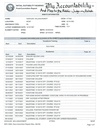
|
2023 apr 5

|
2023 mar 19
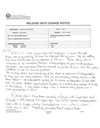
|
2023 mar 5
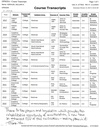
|
2023 mar 5
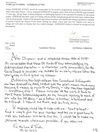
|
2023 mar 5

|
More... |
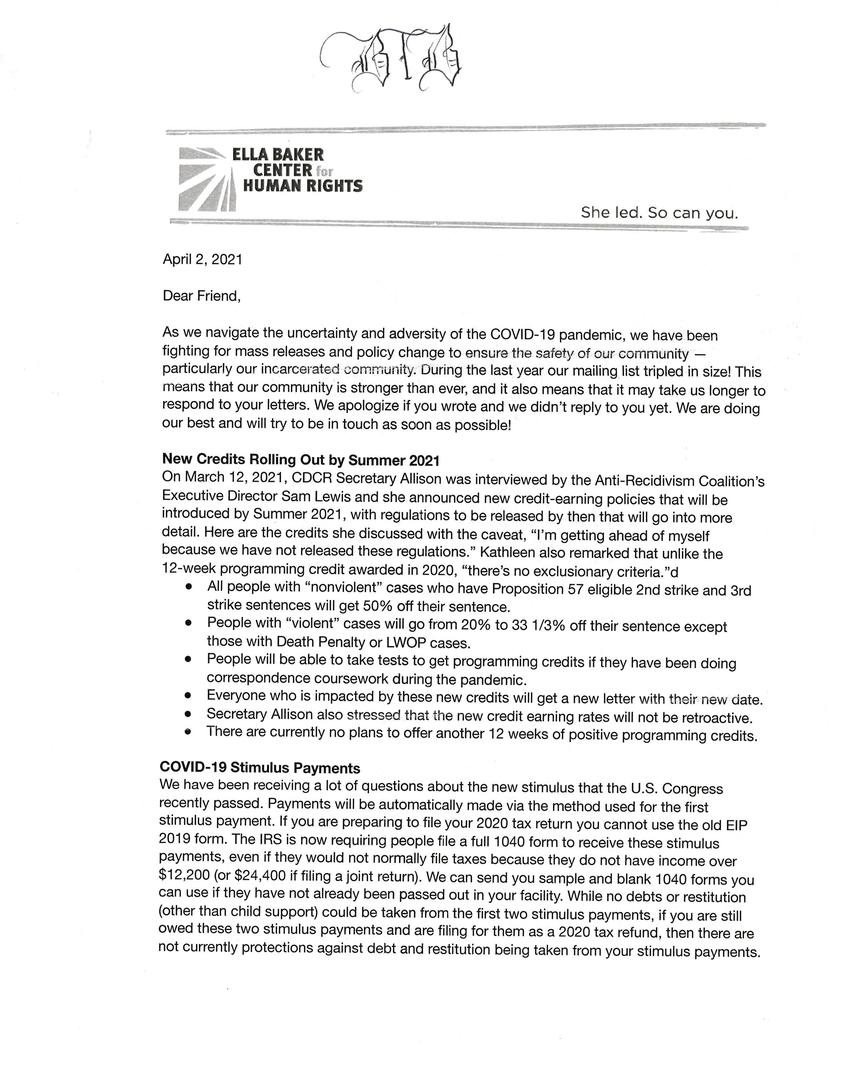
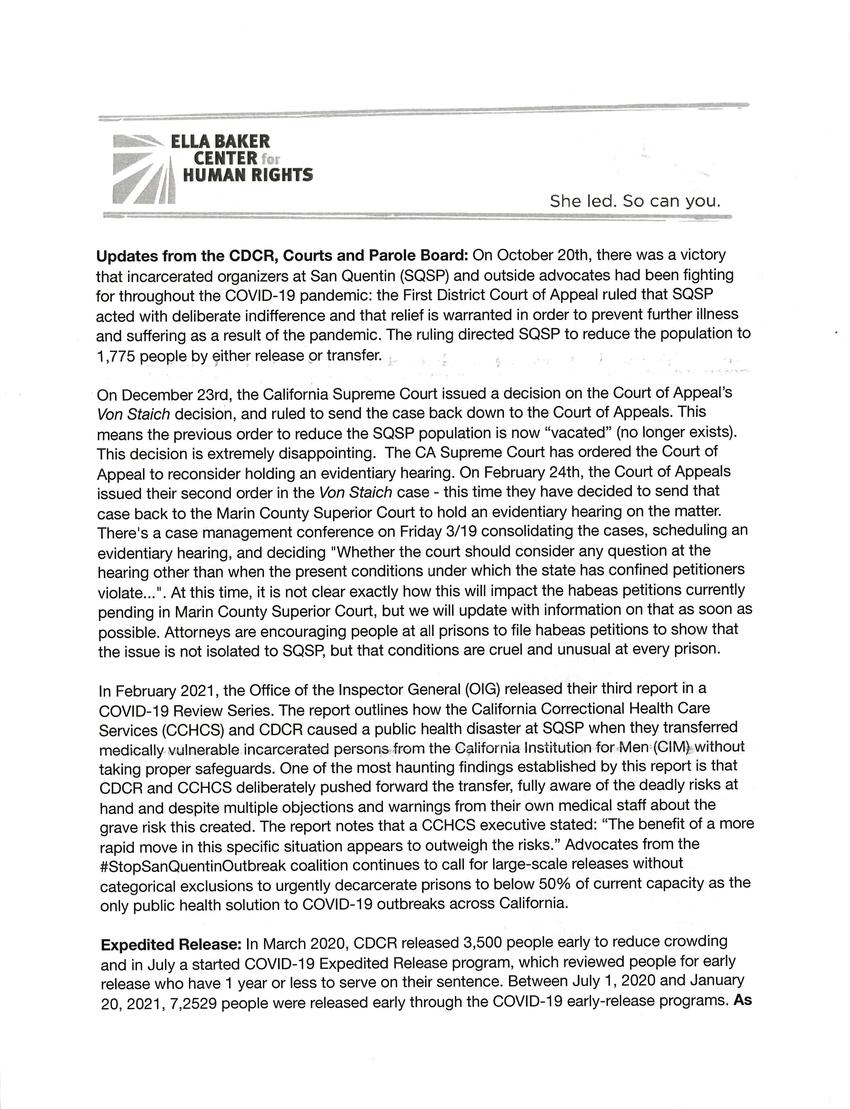
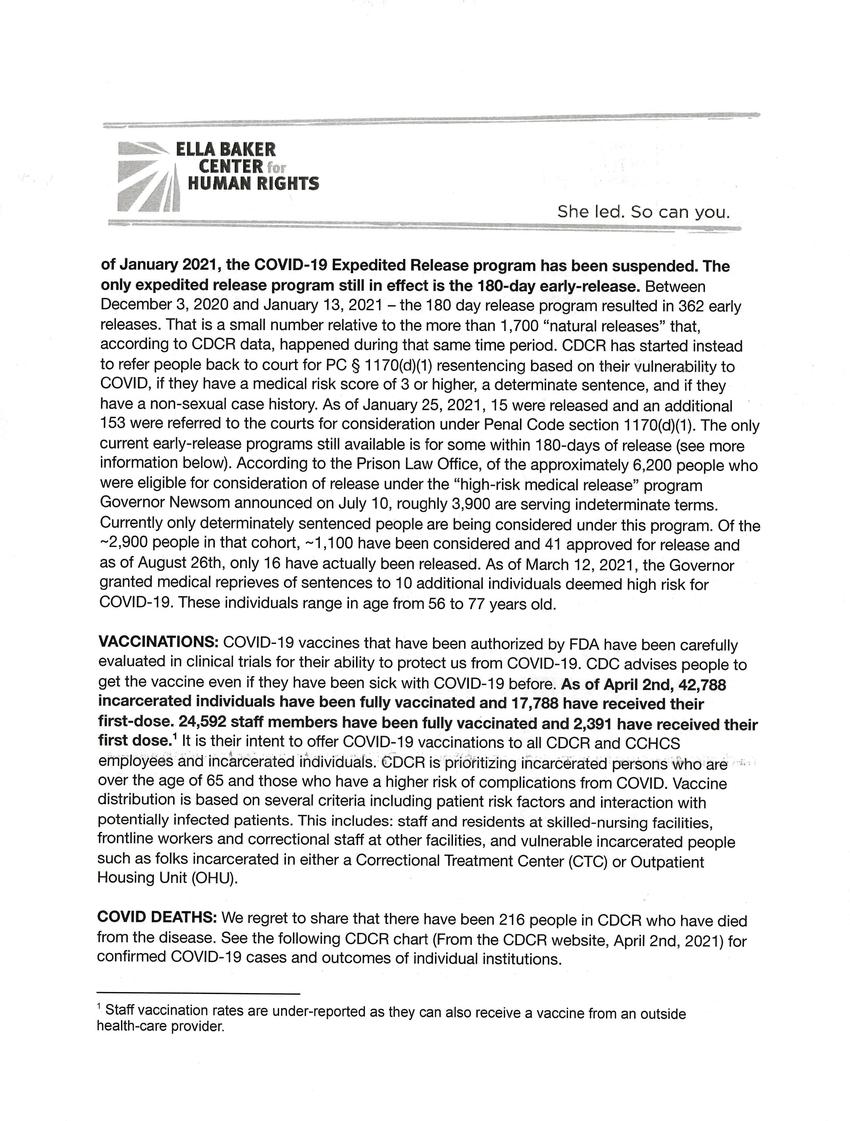
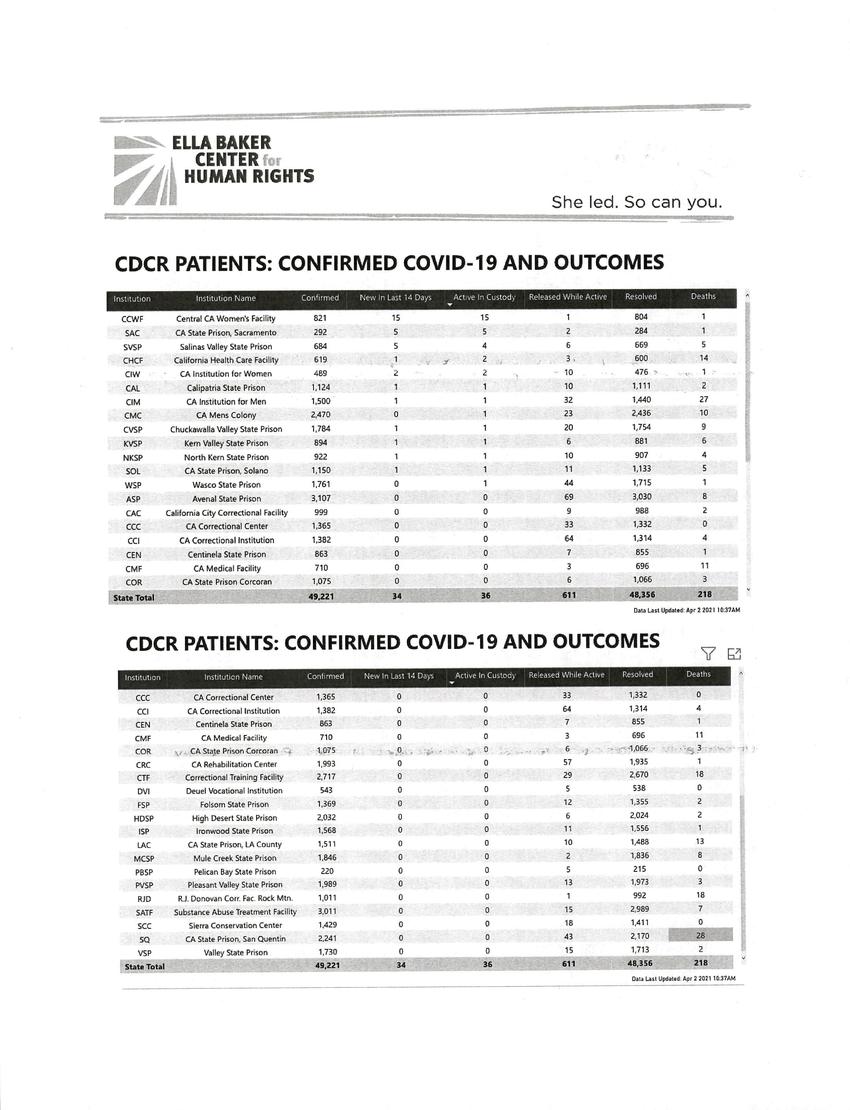
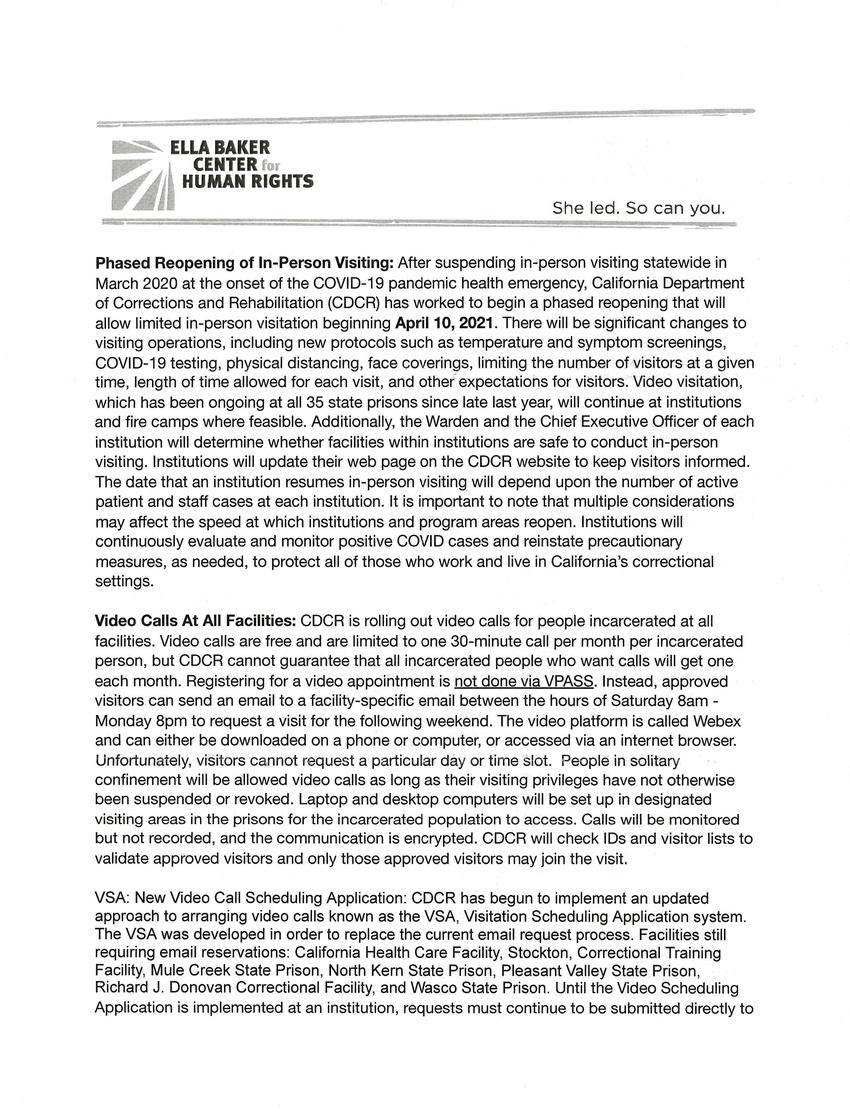
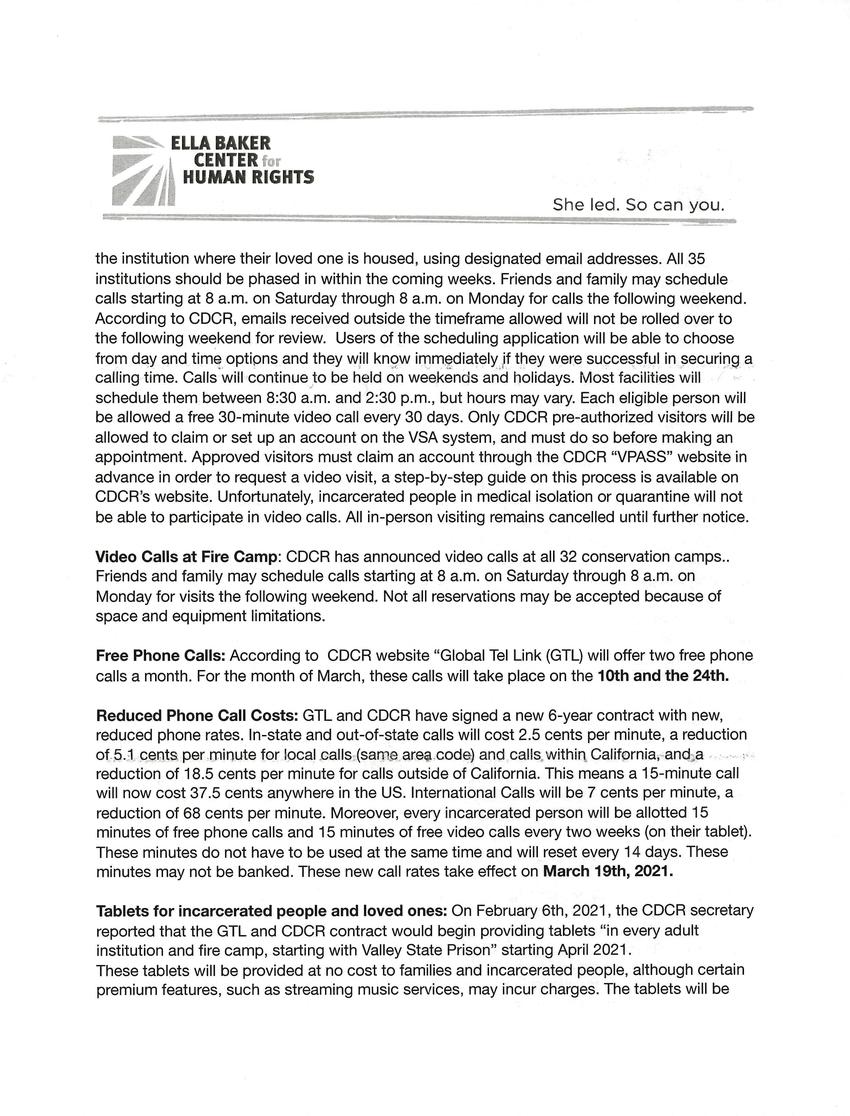

Replies (2)